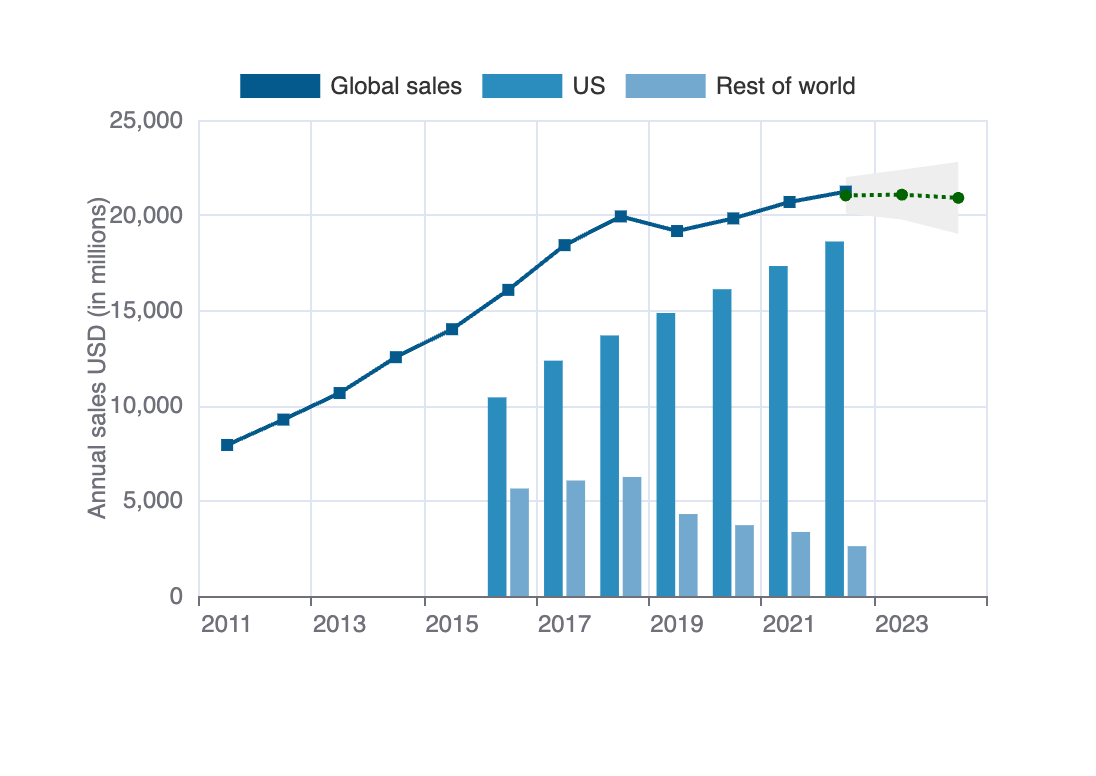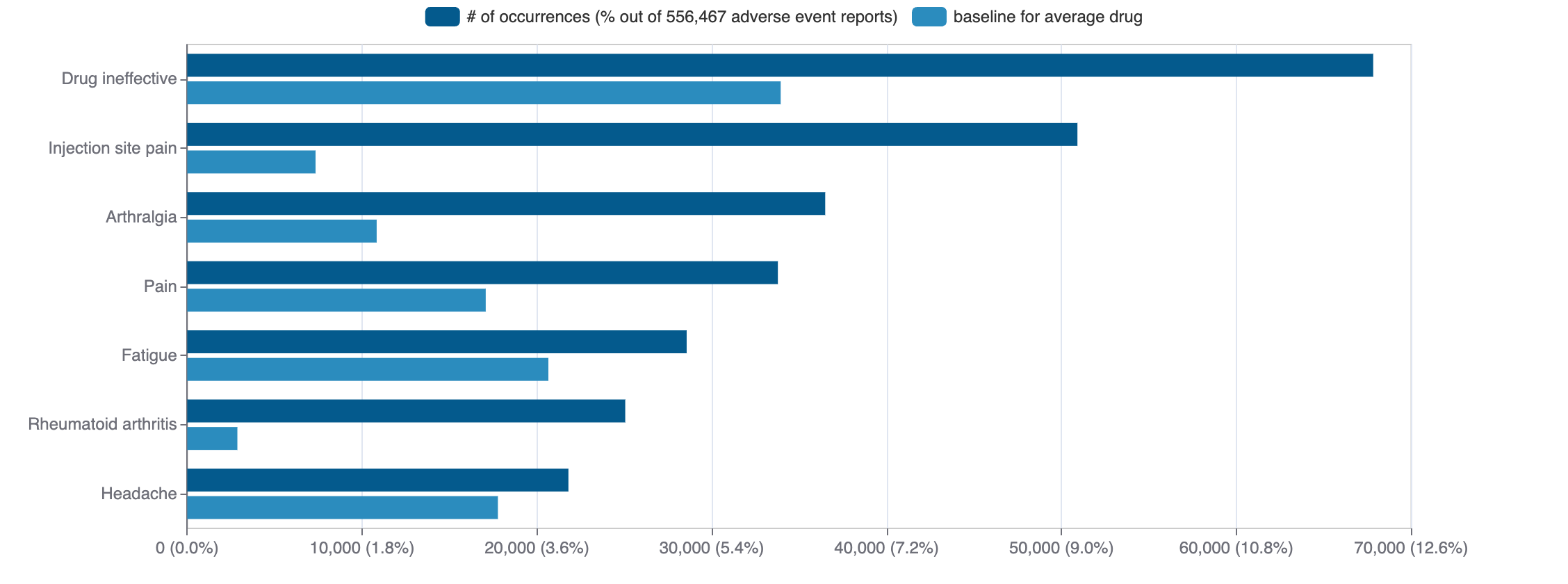Cometriq(cabozantinib)
Cabometyx, Cometriq (cabozantinib) is a small molecule pharmaceutical. Cabozantinib was first approved as Cometriq on 2012-11-29. It is used to treat renal cell carcinoma in the USA. It has been approved in Europe to treat hepatocellular carcinoma, renal cell carcinoma, and thyroid neoplasms. The pharmaceutical is active against vascular endothelial growth factor receptor 2 and hepatocyte growth factor receptor. In addition, it is known to target proto-oncogene tyrosine-protein kinase receptor Ret.
Download report
Favorite
Commercial
Therapeutic Areas
Therapeutic Area | MeSH |
|---|---|
| neoplasms | D009369 |
| digestive system diseases | D004066 |
| urogenital diseases | D000091642 |
| endocrine system diseases | D004700 |
Trade Name
FDA
EMA
Cabometyx, Cometriq
Drug Products
FDA
EMA
Indications
FDA
EMA
Indication | Ontology | MeSH | ICD-10 |
|---|---|---|---|
| renal cell carcinoma | EFO_0000376 | D002292 | — |
Agency Specific
FDA
EMA
Expiration | Code | ||
|---|---|---|---|
CABOZANTINIB S-MALATE, CABOMETYX, EXELIXIS INC | |||
| 2028-09-17 | ODE-375 | ||
| 2026-01-14 | ODE-227 | ||
| 2024-09-17 | I-873 | ||
| 2024-01-22 | I-854 | ||
Patent Expiration
Patent | Expires | Flag | FDA Information |
|---|---|---|---|
| Cabozantinib S-Malate, Cabometyx, Exelixis Inc | |||
| 9724342 | 2033-07-09 | DP | |
| 11298349 | 2032-02-10 | DP | |
| 10034873 | 2031-07-18 | U-2488 | |
| 10039757 | 2031-07-18 | U-1480 | |
| 8877776 | 2030-10-08 | DS, DP | U-1617, U-3225 |
| 11091439 | 2030-01-15 | DP | |
| 11091440 | 2030-01-15 | DP | |
| 11098015 | 2030-01-15 | U-1220, U-1480, U-1617, U-2488, U-3225 | |
| 7579473 | 2026-08-14 | DS, DP | |
| 8497284 | 2024-09-24 | U-1220, U-1480, U-2488 | |
| Cabozantinib S-Malate, Cometriq, Exelixis | |||
| 9717720 | 2032-02-10 | DP | |
HCPCS
No data
Clinical
Clinical Trials
223 clinical trials
View more details

Mock data
Subscribe for the real data
Subscribe for the real data
Indications Phases 4
Indication | MeSH | Ontology | ICD-10 | Ph 1 | Ph 2 | Ph 3 | Ph 4 | Other | Total |
|---|---|---|---|---|---|---|---|---|---|
| Liver neoplasms | D008113 | EFO_1001513 | C22.0 | 5 | 16 | 2 | 1 | 1 | 22 |
| Papillary thyroid cancer | D000077273 | 1 | 3 | 2 | 1 | 1 | 8 |
Indications Phases 3
Indication | MeSH | Ontology | ICD-10 | Ph 1 | Ph 2 | Ph 3 | Ph 4 | Other | Total |
|---|---|---|---|---|---|---|---|---|---|
| Renal cell carcinoma | D002292 | 13 | 32 | 7 | — | 5 | 53 | ||
| Prostatic neoplasms | D011471 | C61 | 4 | 12 | 3 | — | 1 | 19 | |
| Neoplasms | D009369 | C80 | 6 | 11 | 1 | — | — | 18 | |
| Non-small-cell lung carcinoma | D002289 | 6 | 13 | 1 | — | — | 17 | ||
| Thyroid neoplasms | D013964 | EFO_0003841 | 4 | 6 | 2 | — | 1 | 12 | |
| Castration-resistant prostatic neoplasms | D064129 | 4 | 6 | 2 | — | — | 11 | ||
| Neuroendocrine tumors | D018358 | EFO_1001901 | D3A.8 | 2 | 7 | 1 | — | — | 9 |
| Adenocarcinoma | D000230 | 1 | 5 | 1 | — | — | 7 | ||
| Urinary bladder neoplasms | D001749 | C67 | — | 5 | 1 | — | — | 6 | |
| Osteosarcoma | D012516 | 1 | 5 | 1 | — | — | 6 |
Show 6 more
Indications Phases 2
Indication | MeSH | Ontology | ICD-10 | Ph 1 | Ph 2 | Ph 3 | Ph 4 | Other | Total |
|---|---|---|---|---|---|---|---|---|---|
| Hepatocellular carcinoma | D006528 | C22.0 | 4 | 6 | — | — | — | 9 | |
| Urologic neoplasms | D014571 | C64-C68 | 4 | 5 | — | — | — | 8 | |
| Colorectal neoplasms | D015179 | 5 | 4 | — | — | — | 7 | ||
| Breast neoplasms | D001943 | EFO_0003869 | C50 | 3 | 4 | — | — | — | 7 |
| Sarcoma | D012509 | 1 | 7 | — | — | — | 7 | ||
| Kidney neoplasms | D007680 | EFO_0003865 | C64 | 1 | 6 | — | — | — | 7 |
| Melanoma | D008545 | 4 | 3 | — | — | — | 6 | ||
| Ovarian neoplasms | D010051 | EFO_0003893 | C56 | 3 | 3 | — | — | — | 5 |
| Pancreatic neoplasms | D010190 | EFO_0003860 | C25 | 2 | 3 | — | — | — | 5 |
| Head and neck neoplasms | D006258 | 2 | 3 | — | — | — | 4 |
Show 59 more
Indications Phases 1
Indication | MeSH | Ontology | ICD-10 | Ph 1 | Ph 2 | Ph 3 | Ph 4 | Other | Total |
|---|---|---|---|---|---|---|---|---|---|
| Myeloid leukemia acute | D015470 | C92.0 | 2 | — | — | — | — | 2 | |
| Hiv infections | D015658 | EFO_0000764 | B20 | 2 | — | — | — | — | 2 |
| Healthy volunteers/patients | — | 2 | — | — | — | — | 2 | ||
| Myelodysplastic syndromes | D009190 | D46 | 1 | — | — | — | — | 1 | |
| Hematologic neoplasms | D019337 | 1 | — | — | — | — | 1 | ||
| Non-hodgkin lymphoma | D008228 | C85.9 | 1 | — | — | — | — | 1 | |
| Primary myelofibrosis | D055728 | D47.4 | 1 | — | — | — | — | 1 | |
| Precursor cell lymphoblastic leukemia-lymphoma | D054198 | C91.0 | 1 | — | — | — | — | 1 | |
| B-cell chronic lymphocytic leukemia | D015451 | C91.1 | 1 | — | — | — | — | 1 | |
| Bcr-abl positive chronic myelogenous leukemia | D015464 | EFO_0000340 | 1 | — | — | — | — | 1 |
Show 13 more
Indications Without Phase
No data
Epidemiology
Epidemiological information for investigational and approved indications
View more details
Drug
General
| Drug common name | CABOZANTINIB |
| INN | cabozantinib |
| Description | Cabozantinib is a dicarboxylic acid diamide that is N-phenyl-N'-(4-fluorophenyl)cyclopropane-1,1-dicarboxamide in which the hydrogen at position 4 on the phenyl ring is substituted by a (6,7-dimethoxyquinolin-4-yl)oxy group. A multi-tyrosine kinase inhibitor, used (as its malate salt) for the treatment of progressive, metastatic, medullary thyroid cancer. It has a role as a tyrosine kinase inhibitor and an antineoplastic agent. It is a member of quinolines, an organofluorine compound, an aromatic ether and a dicarboxylic acid diamide. |
| Classification | Small molecule |
| Drug class | tyrosine kinase inhibitors |
| Image (chem structure or protein) | |
| Structure (InChI/SMILES or Protein Sequence) | COc1cc2nccc(Oc3ccc(NC(=O)C4(C(=O)Nc5ccc(F)cc5)CC4)cc3)c2cc1OC |
Identifiers
| PDB | — |
| CAS-ID | 849217-68-1 |
| RxCUI | 1363268 |
| ChEMBL ID | CHEMBL2105717 |
| ChEBI ID | 72317 |
| PubChem CID | 25102847 |
| DrugBank | DB08875 |
| UNII ID | 1C39JW444G (ChemIDplus, GSRS) |
Target
Agency Approved
KDR
KDR
MET
MET
Organism
Homo sapiens
Gene name
KDR
Gene synonyms
FLK1, VEGFR2
NCBI Gene ID
Protein name
vascular endothelial growth factor receptor 2
Protein synonyms
CD309, Fetal liver kinase 1, fetal liver kinase-1, FLK-1, KDR, Kinase insert domain receptor, kinase insert domain receptor (a type III receptor tyrosine kinase), Protein-tyrosine kinase receptor flk-1, soluble VEGFR2, tyrosine kinase growth factor receptor
Uniprot ID
Mouse ortholog
Kdr (16542)
vascular endothelial growth factor receptor 2 (Q8VCD0)
Alternate
RET
RET
Organism
Homo sapiens
Gene name
RET
Gene synonyms
CDHF12, CDHR16, PTC, RET51
NCBI Gene ID
Protein name
proto-oncogene tyrosine-protein kinase receptor Ret
Protein synonyms
Cadherin family member 12, cadherin-related family member 16, Proto-oncogene c-Ret, rearranged during transfection, ret proto-oncogene (multiple endocrine neoplasia and medullary thyroid carcinoma 1, Hirschsprung disease), RET receptor tyrosine kinase
Uniprot ID
Mouse ortholog
Ret (19713)
proto-oncogene tyrosine-protein kinase receptor Ret (P35546)
Variants
Clinical Variant
No data
Financial
Cabometyx - Exelixis
$
€
£
₣

Mock data
Subscribe for the real data
Subscribe for the real data

Mock data
Subscribe for the real data
Subscribe for the real data
Cometriq - Exelixis
$
€
£
₣

Mock data
Subscribe for the real data
Subscribe for the real data

Mock data
Subscribe for the real data
Subscribe for the real data
Tabular view
Trends
PubMed Central
Top Terms for Disease or Syndrome:

Mock data
Subscribe for the real data
Subscribe for the real data
Additional graphs summarizing 8,323 documents
View more details
Safety
Black-box Warning
No Black-box warning
Adverse Events
Top Adverse Reactions

Mock data
Subscribe for the real data
Subscribe for the real data
375 adverse events reported
View more details
Premium feature
Learn more about premium features at pharmakb.com
Learn more
